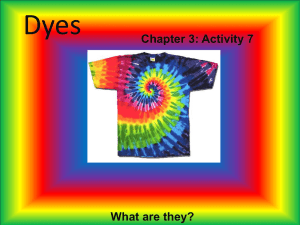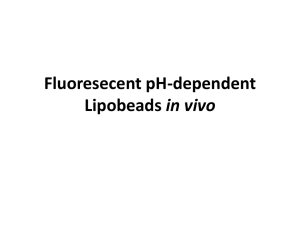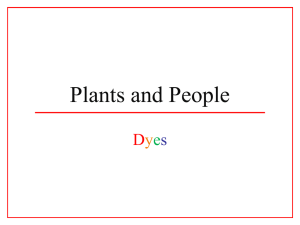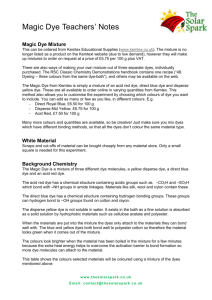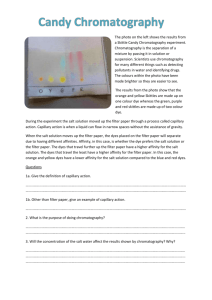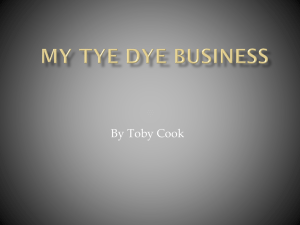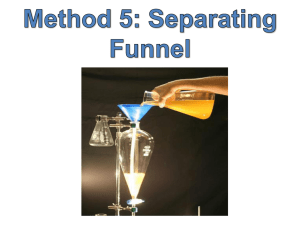Wordfile
advertisement
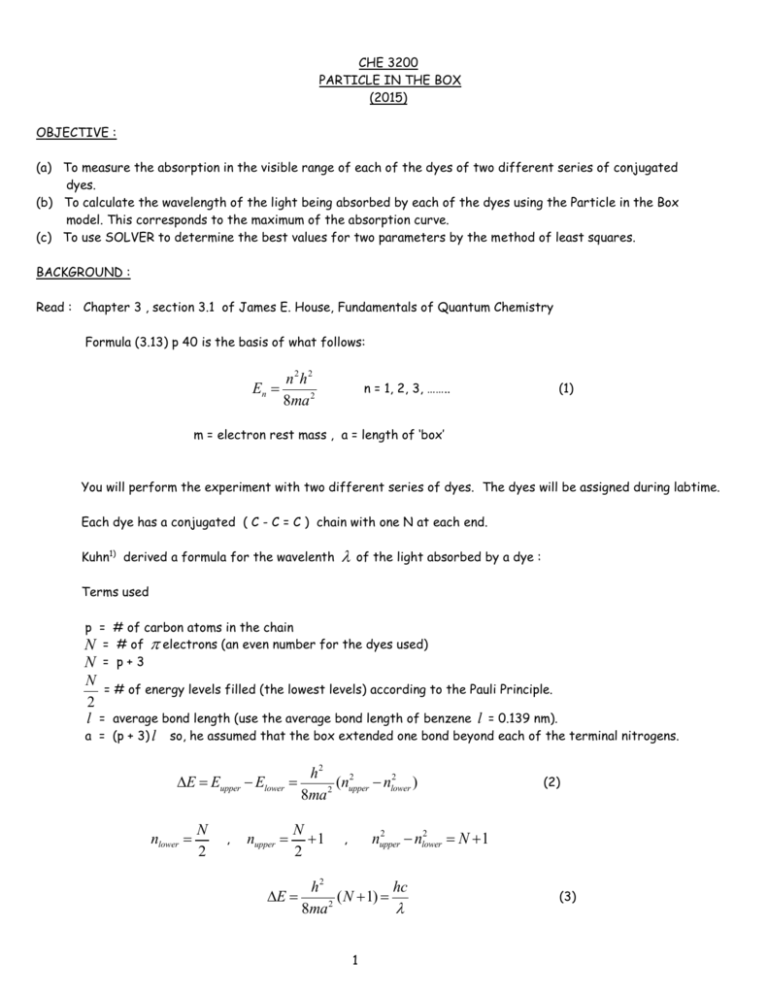
CHE 3200 PARTICLE IN THE BOX (2015) OBJECTIVE : (a) To measure the absorption in the visible range of each of the dyes of two different series of conjugated dyes. (b) To calculate the wavelength of the light being absorbed by each of the dyes using the Particle in the Box model. This corresponds to the maximum of the absorption curve. (c) To use SOLVER to determine the best values for two parameters by the method of least squares. BACKGROUND : Read : Chapter 3 , section 3.1 of James E. House, Fundamentals of Quantum Chemistry Formula (3.13) p 40 is the basis of what follows: En = n2h2 8ma 2 n = 1, 2, 3, …….. (1) m = electron rest mass , a = length of ‘box’ You will perform the experiment with two different series of dyes. The dyes will be assigned during labtime. Each dye has a conjugated ( C - C = C ) chain with one N at each end. Kuhn1) derived a formula for the wavelenth l of the light absorbed by a dye : Terms used p = # of carbon atoms in the chain N = # of p electrons (an even number for the dyes used) N = p+3 N = # of energy levels filled (the lowest levels) according to the Pauli Principle. 2 l = average bond length (use the average bond length of benzene l = 0.139 nm). a = (p + 3) l so, he assumed that the box extended one bond beyond each of the terminal nitrogens. DE = Eupper - Elower = nlower = N 2 , nupper = h2 2 2 (nupper - nlower ) 2 8ma N +1 2 DE = (2) 2 2 nupper - nlower = N +1 , h2 hc (N +1) = 2 8ma l 1 (3) l= 8mc a 2 8mc [l(p + 3)]2 = h (N +1) h (p + 4) l= 8mc [l(p + 3)]2 h (p + 4) Kuhn1) (4) There have been several variations (improvements) of this formula : 8mc [l(p + 3+ a )]2 l= h (p + 4) Garland2) (5) Moog3) (6) l = benzene C C bond length a = a numerical factor (fudge factor) l= 8mc (b × l + g )2 h (p + 4) b = actual # of bonds between the nitrogens = p + 1 l = average bond length along the chain g = empirical factor that accounts of all of the additional lengthening of the chain beyond the two end atoms (N) Garland’s formula and Moog’s are identical when we set b = p + 1 and g = (2 + a)l 8mc (b × l + g )2 8mc ((p+1)× l + 2l + al)2 8mc (pl + 3l + al)2 8mcl 2 (p + 3+ a )2 l= = = = h (p + 4) h (p + 4) h (p + 4) h (p + 4) We will use Moog’s formula with b=p+1 8m c [l(p +1) + g ]2 l= h (p + 4) (7) with two further variations : (1) Kuhn’s treatment assumes that the C=C-C chain in the molecules is straight. Since the C=C-C chain is actually a zig-zag, the bond length l must be modified. We will use an ‘effective’ bond length d. d has to be between d = l = 0.139 nm and d = l cos30o = 0.139.(cos30) = 0.120 nm.Therefore we will replace l by d (2) We add 2 g instead of g l= 8m c [d(p +1) + 2g ]2 h (p + 4) So, instead of one parameter (fudge factor) we will have two: d = the effective bond lenth of each bond between the two nitrogens (0.120 g = the additional length of the box beyond each of the two nitrogens. The goal of the experiment is to find the best d and (d and g g (8) £ £ for each of the series of dyes should be constant for one series but different for different series). 2 d 0.139). You will perform the experiment with two different series of dyes. Series available are : Series A has 3 dyes (A1, A2, A3, A4) Series B has 3 dyes (B1, B2, B3) Series D has 4 Dyes (D1, D2, D3, D4) The series will be assigned to your group during labtime. METHOD : For each dye prepare a solution using methanol (spectrograde) as solvent. Specific instructions on how to make the solutions will be given to you in lab. The use of the UV/Visible Spectrometer and the LabQuest will be demonstrated in lab. Record the absorption spectrum of each dye. For each dye record the wavelength of the absorption maximum. The spectrum of each dye should be a single line. When a shoulder appears, dilute the solution further and take the spectrum again. If the shoulder is still there disregard the shoulder. When you are done with the spectra of each dye of a series mix the solutions of all dyes of that series and record the combination spectrum. CALCULATIONS : For each of your two series of dyes set up a new Excel spreadsheat using the followig (or similar) format : 8mc = 3297.184 nm-1 h You can use 1 2 3 4 5 6 7 8 9 10 11 A Dye B p C l (measured) / nm D E l (calculated) / nm d 2 i 1 2 3 4 Sum 8mc/h= l (nm)= 3297.184 0.139 g / l= g/d= Enter reasonable values for d and g di2 d= g= in D8 and D9 Enter your measured values for l in C2, C3, etc In D2, D3, etc calculate l using equation (8) In E2, E3, etc calculate the square of the difference of the measured and the calculated In E6 calculate the sum of the squares. Highlight cell E6, go to the TOOLS menu and select SOLVER. ls If you don't see SOLVER in the TOOLS menu, go to ADD-INS and select the SOLVER Add-in. Click OK. Solver will be loaded and will then appear in the TOOLS menu. Highlight Cell E6 and call up SOLVER 3 F The following window will appear: Set Objective to : $E6$ Highlight : Min By Changing Variable Cells : $D8$:$D$9 Click on Options and make sure the following three windows are set as follows ; 4 Click : OK Click : Solve D8 and D9 should now show the optimized values for d and g but you should expect SOLVER to take some time to do the iterations. GRAPHS : For each series of dyes graph l (calculated) versus l (measured) For each series of dyes run LINEST and include the error in y as errorbar for each point. Include the LINEST values for each graph. REPORT : Use the “Guidelines for Writing Labreports” There will not be a formal error analysis, but you can discuss the errors on the basis of the sum of the åd squares 2 i Don’t forget to: Include the spectra. One spectrum for each dye of each series plus a combination of all dyes of that series. (one set of spectra per group will be enough). Include your spreadsheets. (LINEST and SOLVER). For each series report the optimum d and g Comment on the results What do d and g tell us ? How can g be interpreted ? Remember that we are using a very simple model (particle in the box with vertical walls and V 1. ® ¥ ) for these dyes. H. Kuhn, J. Chem. Phys. 17, 1198 (1949); Fortsch. Chem. Organ. Naturstoffe 17, 404 (1959). 2 . C. W. Garland, J. W. Nibler, D. P. Shoemaker, Experiments in Physical Chemistry, 8th. ed. p. 395, McGrawHill. 3. R. S. Moog, J. Chem. Ed. 68, Number 6, 506 (1991) 5

